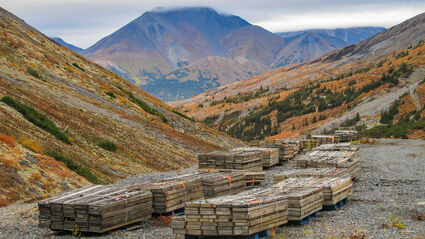Boundary zinc could boost Macmillan Pass
North of 60 Mining News – October 18, 2019
Last updated 9/26/2020 at 10:59am

Fireweed Zinc Ltd.
Stacks of core from historical drilling at MacMillan Pass, a road accessible zinc-lead-silver project in eastern Yukon.
Fireweed Zinc Ltd. Oct. 16 reported that drills cut 250 meters averaging 3.44 percent zinc from the surface at Boundary, a zone currently not included in the resource for the company's Macmillan Pass project in eastern Yukon.
Two deposits at Macmillan Pass – Tom and Jason – host 11.21 million metric tons of indicated resource averaging 6.59 percent (1.63 billion pounds) zinc, 2.48 percent (610 million lb) lead and 21.33 grams per metric ton (7.7 million ounces) silver; plus 39.47 million metric tons of inferred resource averaging 5.84 percent (5.08 billion lb) zinc, 3.14 percent (2.73 billion lb) lead and 38.15 g/t (48.4 million oz) silver.
Situated about 15 road-kilometers (nine miles) west of the Jason deposit, Boundary has the potential to expand these resources and improve the economics of establishing a zinc mine at Macmillan Pass.
The 250-meter-long intercept in NB19-001, the first hole drilled this year at Boundary, included a 23.31-meter section averaging 16.35 percent zinc and 27.9 g/t silver from a depth of 93.69 meters; and 11.85 meters of 9.18 percent zinc, 4.45 percent lead and 71.6 g/t silver from 226.2 meters.
"These results confirm the large size and upside potential of Boundary zone," said Fireweed Zinc CEO Brandon Macdonald. "Hole NB19-001 is the best ever hole drilled in this zone and clearly demonstrates that there may be potential beyond the past wide, but lower grade, intersections drilled historically, as impressive as they were."
The 24 holes previously drilled at Boundary Zone indicate the presence of a large bulk tonnage zone of zinc-lead-silver mineralization potentially suitable for open pit mining. This 200- to 800-meter wide zone of mineralization has been traced for nearly 2,000 meters along strike and about 250 meters thick at its center. The grades of the historical drilling averaged around 2.5 percent zinc with multiple higher-grade intervals closer to surface.
Higher grades near surface are favorable for potential open pit mining economics, especially with the addition of ore sorting technology to improve the grade of mill feed.
Initial test results indicate that Boundary mineralization is potentially amendable to low-cost X-Ray Fluorescence (XRF) ore sorting technology. During these tests, 50 to 70 percent of the waste material was rejected while 80 to 85 percent of the zinc was recovered. This means that the mined material averaging 2.5 percent zinc would be upgraded to 5 percent before being fed to the mill, while recovering 80 to 85 percent of the contained zinc.
Core collected from the two 2019 holes, assays are pending from the second hole, will be used to carry out commercial-scale ore sorting and metallurgical tests. If the tests confirm the preliminary ore sorting results, the Boundary Zone has the potential to significantly improve the economics of the Macmillan Pass project.
"Boundary Zone results along with recent drilling success at Tom North and End Zone, have potential to expand on our current resources, which are already among the largest undeveloped zinc resources in the world, as well as improve project economics," said Macdonald.
–SHANE LASLEY
CORRECTION (Nov. 5, 2019): This article has been corrected to clarify that Boundary zone is not included in the resource estimation for the Macmillan Pass project.










Reader Comments(0)